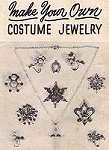
Researching Costume Jewelry History, Companies and Signatures: Further Research Needed
August 24, 2019
Hobbycraft Supply Service Do It Yourself Jewelry Catalog 1950
August 24, 2019Costume Jewelry Collectors Int'l
is pleased to host
RESEARCHING COSTUME JEWELRY
originally created and published by Dotty Stringfield on IllusionJewels.com
by Diane DeMango
©2009
I have sold many pieces of jewelry with saphiret and sappharine stones over the last 3 years, most of them go to Japan where, apparently, they never go out of style. There is not much information out there regarding these stones. I have been trying to learn as much as I can about them. I am writing this article to share what I have learned. If anyone out there feels this information is wrong in any way, please contact me, so I can make corrections.
Saphiret glass was made in Gablonz, Czechoslovakia in the mid-19th century by mixing melted gold into sapphire-colored glass. The result was a glass which looked brick red or brown, but reflected blue on the surface. Because they are glass, these stones are rarely found in precious metal findings. All the pieces I've owned are brass or gold-filled. Occasionally, you will see a faceted saphiret stone in a gold Victorian ring.
I was told that production of this glass was stopped shortly after the turn of the century, because it was no longer cost-effective as gold had increased in value. Thus, pieces of jewelry containing saphirets are either Victorian, Edwardian, or Arts and Crafts. I have never seen Deco pieces set with them, and have only, on one occasion, seen saphiret glass stones set in modern pieces. Those pieces were by the Sadie Green Co. Photos of that set will be shown later in this article.
Sappharine stones are manufactured in Germany. These stones were made to mimic the earlier saphirets. I don't know when they started manufacturing them but Weiss, Regency and Florenza used them in many of their 1950s jewelry designs - so perhaps that's when they were first produced.
People who collect the early saphiret jewelry usually make the distinction between saphiret and sappharine stones. When I list an old piece on the net, I use the word saphiret in the title. When I list a sappharine piece, I use both words in the title, to let folks know it is the newer German stone. Inevitably, I will still get a hardcore collector lecturing me about how real saphirets are no longer made and how I shouldn't be using the word. Based on my experience, Japanese buyers make no distinction - and call both types of stones saphirets.
People often ask me what the difference is between the 2 stones. Compared to saphirets, sappharines look faded. The contrast between the brown and blue is much more pronounced in saphirets. Sappharines can appear light tan or mauve. However, both stones change color and contrast in different light - which is why I always try to photograph them with and without a flash. Also, sappharines are fairly consistent in color, whereas saphirets have a wide range of clarity and density to them based on the ratio of melted gold to blue glass. Stones that reflect vivid blue had less gold added in.
I started getting requests for saphiret/sappharine jewelry in 2005, about the time major fashion houses were reviving that chocolate brown/aqua blue color combination from the early 1970s. These colors were huge in Japan - hence the popularity of not only saphiret jewelry but butterfly wing jewelry as well (which reflects blue and brown).
While doing my net searches, I turned up several stones mistakenly called saphirets. One site had butterfly wing jewelry - the stones were called saphiret. I have also seen Mexican fire opals (also called "dragon's breath") - as well as moonstones referred to as saphirets. In all the years I have been in the CJ business, I have only met 4 people who knew what saphirets were when I asked if they had any. I now keep saphiret cufflinks in my pocket when shopping - it saves so much time. Instead of trying to describe the stone, I just pull them out and ask - "do you have jewelry with stones that look like this?"
The following photo gallery has comparison photos of jewelry with early saphiret stones and modern sappharine stones. Hopefully, this will help folks identify them. I will start with photos of jewelry containing antique saphirets.
Here are 3 dainty Victorian/Edwardian pins with saphiret stones. The first has wonderful faceted heart-shaped stones. I bought this "as found" with one stone missing and a smooth white frosted stone in its' place.
 |  |  |
Next is a fabulous brass belt, c1880, with round faceted saphirets bezel-set in every other link.
 |  |
This hatpin was found in a consignment shop - where someone had made up new hatpins from large, antique glass beads. Notice how dense the color is on the saphiret bead.
 |
On rare occasions, you can find early saphiret glass with molded images on them. This set was made by the Sadie Green Co., founded c1970 here in Mass. They make antique reproduction jewelry using new stamped brass findings and antique glass. This set was a real find - and proof that they do, indeed, use antique glass. These cameo-style saphiret pieces are from the turn of the century.
 |  |
The following pieces contain sappharine stones - the modern version of saphirets. Here is a beautiful large Regency pin with sappharine stones. The first photo was taken in available light, the other with a flash. Notice the color change in the sappharines, from light brown to brick red.
 |  |
Weiss made beautiful jewelry with sappharine stones. Here is a pin/earring set with sappharine navettes.
 |  |
These Weiss clips have teardrop-shaped sappharine stones.
 |
The following earrings are by Whiting and Davis. They are part of a full parure made by W&D which uses large oval sappharine cabochons. I have owned all the pieces at one time or another - but, alas, never the whole set at once. This set can be found in both gold and silvertone.
 |  |
Finally, here is an unsigned pin with a big sappharine center stone.
 |
This wraps up my article on 19th century saphiret glass and its' modern "cousin", sappharine . I do not consider myself an expert but, if anyone has questions or would like me to confirm whether something they have is saphiret or sappharine, feel free to contact me - I am always happy to help. Contact me at bantiques@earthlink.net.
Researching Costume Jewelry -- Home
Copyright 1997 to present — www.costumejewelrycollectors.com — All Rights Reserved.
All RCJ publications and pages were created
by Dotty Stringfield with the assistance of research contributor Pat Seal
and other valued members of the costume jewelry collecting community.


